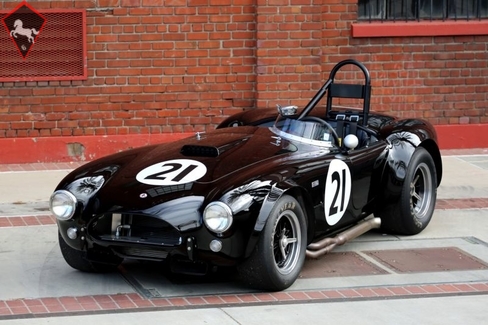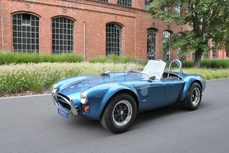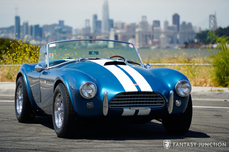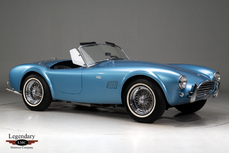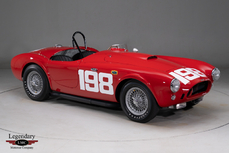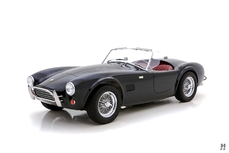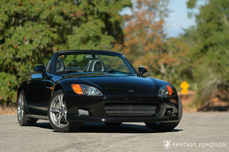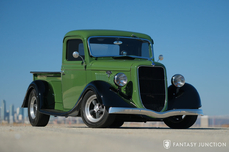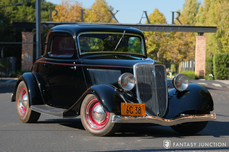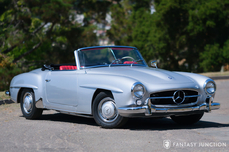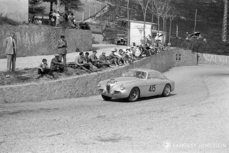AC Cobra 289 289 cu in V8 1964
Allmän beskrivning :
1965 Ford 289 Shelby Cobra
s/n COB5998
Black with Black Leather Interior
The Shelby Cobra is one of the most iconic sports cars of all time. A legendary car that combines world-class motorsports pedigree, brutally American performance, and sophisticated European style and engineering, it transcends several segments of the classic car world and is one of those rare cars that is revered equally on both sides of the Atlantic by sports car and hot rod/muscle car enthusiasts alike.
The Cobra is the result of a unique set of circumstances. AC's Ace roadster had been powered by Bristol and later Ford Zephyr six-cylinder engines, but when these engines ended production, it appeared they would have to stop making their quintessentially British sports car. At the same time, Carroll Shelby had recently retired from motor racing, having won Le Mans driving for Aston Martin in 1959. He was running a driving school and selling Goodyear tires, but wanted a more substantial legacy, and had always dreamed of building his own sports cars.
He approached the various Detroit manufacturers and was eventually offered a small but light 260cid eight-cylinder engine by Ford from their pickup truck line. Aware of AC's predicament, he approached the management with his inimitable flair, and the Cobra was born. The bodies were built by the AC factory in the United Kingdom before being shipped to the Shelby American's Southern California factory. Initial impressions of the car, which was still in bare aluminum, were extremely favorable. Following its first competition outings, the bugs were gradually ironed out, and the car proved to be a durable, quick, and extremely capable competition car.
In addition to being a world-class race car, the Cobra became a cultural icon. It was a media darling and was featured in songs, movies, and races all over the US. Car magazines loved the Cobra, offering a bounty of editorial coverage complete with Shelby himself delivering his inimitable combination of Southern charm and Hollywood bravado. The unapologetic, brash, thumping Ford V8 engine powered Cobra delivered 0-60 times in an astonishing 4.9 seconds, besting contemporary sports cars like Jaguars, Aston Martins, and Corvettes by two to three seconds. The rest, as they say, is history, and the Cobras, in 260cid, 289cid, and 427cid versions went on to achieve tremendous racing success, in addition to becoming culturally ingrained as one of the coolest cars ever made.
This particular car has completely unique and fascinating history. According to the authoritative World Registry of Cobras & GT40s, 4th edition, under direction from Carroll Shelby, this Cobra chassis was originally constructed by AC Cars, intended for use as a “show chassis.” The chassis would showcase the unique tubular frame construction, reveal the 289 engine, and signal to onlookers that serious racing engineering had been employed in the construction of these soon to be released production cars. Period photos confirm the right hand drive, leaf spring chassis was prominently displayed at the Shelby American Los Angeles facility at the May 1965 Ford Motor Company Board of Directors meeting. Photos of this event showcase the chassis shod with Goodyear tires, wire wheels with knock offs, and specially made signage showing “Cobra 289 Show Chassis” on the engine and “Ford Powered” affixed to the independent rear suspension. The chassis served a critical purpose for the growth of Shelby in these early years, validating the mechanical excellence that lurked beneath the aluminum skin of every Cobra that exited the now famous Venice Shelby assembly facility.
In mid-1965, Shelby American employee Bernie Kretzschmar was driving a 1932 Ford roadster to work. Shelby admired the workmanship on this hot rod, suggesting that Kretzschmar dispatch the Cobra show chassis to Tex Collins of Cal Automotive where it could be bodied as a T-Bucket Roadster. Kretzschmar, under the impression that this would be Shelby’s personal car, delivered the chassis to Cal Automotive, who was a Shelby American sub-contractors that produced fiberglass parts for GT350s. Cal Automotive employees Kurt Hamilton and Gayle Black then assembled the T-Bucket directly on the show chassis and invited Shelby to test-drive the car. Finding the experience less than expected, Shelby simply left the finished car with Collins at Cal Automotive. Collins retained the car despite, according to Shelby, having never paid for the show chassis.
In the mid 1970s, Collins sold the car to Gary Bandy, who shipped it to Catalina Island, CA where it remained for four or five years, before returning back to Burbank, CA. The car is understood to have been street registered during this time, and photos of the car depict it with blue six digit California license plates dating from the 1970s. Bandy stored the car in a warehouse filled with other vehicles. In the 1980s, Bandy sold the car to Geoff Shanklin who had recognized the Cobra chassis and unique Cobra components, all of which still remained with the car, and were easily seen given the mostly open construction of the T-Bucket configuration. Shanklin commissioned the fabrication of an aluminum Cobra body from noted Cobra restoration experts at Kimmins Custom Fabrication. Kimmins hand built the body to 289 competition Cobra specs, completing the restoration in 1995 while retaining many of the mechanical components when it was first delivered to Shelby.
During the initial restoration process, care was taken to document the car referencing photographs taken from the T-Bucket body to verify the original components which including the suspension, a complete front end assembly for 289 Cobra, rotors and Girling caliper brakes, and numerous other rare original parts. The all aluminum Cobra body was prepped for paint while the major chassis components were restored with care and attention to originality wherever possible. The car was raced off and on in the 1990s and sold to two next owners, and then restored again to the condition shown today and assigned the chassis number COB5998, the correct three-letter prefix for a right hand drive Cobra.
From 2012-2014, Cobra experts at Cobra Automotive in Wallingford, CT performed extensive and detailed mechanical and cosmetic work on the car totaling over $115,000. Already a proven racing car at various vintage events, the current owner sought to refine and improve on this important car using a combination of specialized performance parts and authentic Cobra equipment. Cobra Automotive carefully sourced a blend of these parts including FIA Magnesium Cobra wheels, Goodyear racing tires, a T-10 transmission with a Tilton 7 ¼” Double disc racing clutch and Jerico 26 spline with 8 rivet disc pack, Hurst Super Shifter with billet shift head, new left and right control arms, KFP Magnum Gold 42-A front and rear Cobra brake pads specifically for Girling CR calipers, and a new Girling master cylinder.
Cobra Automotive also performed a comprehensive engine rebuild beginning with disassembly and measuring. The main crank was measured, balanced, magnafluxed, and micro polished, an all steel harmonic balancer was installed, and a mechanical lifter set with .012” cam face oiling hole bearings was further machined for better oiling. Performance pistons and rings were installed along with new rods, all of which were balanced before reassembly. Other items included a Melling Racing type oil pump, bronze freeze plugs, and Weber carburetor rebuild kits for each of the four twin throat Webers. Upon completion of the engine rebuild, it was dyno tuned running 112 octane racing fuel.
While the engine was out and being dialed through dyno testing, extensive work was also performed on the suspension and chassis components included installing new Penske 7500 series racing shocks at the front and rear, rear uprights/hub carrier left and right, bearings, 427 hubs, as was a new Griffin aluminum race radiator rated for 400-500hp. All soft brake lines, hoses, and various pressure lines were all replaced as needed and electrical tested and repaired or improved in order to ensure proper and reliable performance of all systems.
The entire body shell was stripped to bare aluminum and all raw aluminum features were carefully prepared for repaint using appropriate primers and finishing materials. The car was properly prepped for final color and finished to a high standard including all interior surfaces, inner fenders, under hood and trunk surfaces, and cosmetic finishes on the chassis. The car was completed in time to accept the invitation and participate in the 50thCobra Reunion held in Monterey, CA in 2013.
Today, this Cobra presents in beautifully restored condition combining effective and safe racing specifications with reverence to the historic importance of this unique car. The recently finished black paint is excellent, with mirror finish revealing the beautiful surfacing performed on the aluminum body. Distinctive and aggressive competition touches including front and rear fender flares, wide rear fenders, competition side exhaust, a short windscreen, and competition fuel filler deliver an authentic period racing aesthetic. Throughout the car, sparse but purposeful exterior trim is in excellent condition. The lights, lenses, and emblems are beautifully presented showing only minimal evidence of use. The wheels are correct Halibrand knock off wheels shod with wide Goodyear racing tires, giving a hunkered down stance, filling the flared fenders with competition rubber.
The interior has been restored with a thoughtful series of racing based Cobra elements, carefully updated for safety to meet vintage racing requirements while maintaining an authentic aesthetic. A generous array of Stewart Warner instruments spread out the dash, properly tucked under the rolled aluminum cowling. A series of toggle switches activate various functions while a purposeful leather-rimmed steering wheel echoes the black and aluminum theme. A competition roll bar is installed with modern seatbelt anchors draped over a form-fitting racing seat. Overall, the interior has a nice, clean competition feel to it unlike so many carefully restored Cobras that can often feel a bit sterile, the blend of authenticity and carefully finished components has been very cohesively resolved.
Under the hood, the car reveals an astonishingly restored 289 engine displaying a trumpeted array of Weber carburetors ready for action. The engine is finished consistent with the exterior of the car, combining contemporary and vintage competition features with authentic details. The painted silver valve covers with twin breather caps complement the modern aluminum radiator, electric cooling fan, and aluminum overflow tank. The engine compartment is assembled and finished with superb attention to detail. The same is true of the trunk area, which is clean and properly finished in fiberglass and raw aluminum with correct fuel lines. The underside of the car is also beautifully finished and detailed with a few allowances for modern improvement and safety.
The car fires up easily, instantly generating a whomping growl, followed by a loping performance cadence familiar to anyone who has spent time at a racetrack during a vintage event. The side exit exhaust downs out any other sounds, immediately commanding attention from even distant onlookers. Once behind the wheel, the easily operated 4-speed gear shifter confidently starts you down the road. As with any Cobra, the car opens up rapidly with plenty of low down torque, and in the case of race-prepped motor, a new level of explosive progress is available in the upper rev range. Handling and ride are firm, cutting quickly into corners and exiting strong under hard throttle. Braking is astonishingly good bringing the capable car down smoothly and confidently.
The car is accompanied by the uprights for the full size windshield (the glass itself is missing), 4.30 rear pumpkin, passenger seat, and a spare set of replica Halibrand wheels. Also included are restoration photos, period photos of the car when originally used by Shelby as a show chassis, photos of the Tex Collins T-Bucket period, multiple historic reference letters, and documentation from previous owners, including copious documents and receipts from the most recent restoration.
Combining both an historic and important Shelby development artifact with exceptional restoration and authentic competition features, this unique 289 Cobra has truly exceptional history unlike that of any other Cobra. With its one of a kind and vital Shelby history, impeccable restoration, and competition spirit, COB5998 is ready for enjoyable showing, historic events, or simply to admire for its critical contribution to the Shelby name, faithfully curated by decades of enthusiasts preserving the Cobra legacy.Pre-1957 street car trades considered.
http://fantasyjunction.com/cars/2122-Ford-289%20Shelby%20Cobra-289%20cu%20in%20V8
1964 AC Cobra 289 289 cu in V8 is listed såld on ClassicDigest in Emeryville by Fantasy Junction for $460000.
Fakta i bilen
Karosstyp : Personbil Märke : AC Modell : Cobra 289 Modellversion : 289 cu in V8 Motorvolym : 0.0 Årsmodell : 1964 Läge : Emeryville
Såld
Information om säljaren
Såld
People who viewed this AC Cobra 289 also viewed similar AC listed at ClassicDigest
Other cars listed for sale by this dealer
om AC Cobra 289
1962 blev AC kontaktad av en viss Carroll Shelby att använda ett litet block Ford V8-motor i ess, producerar AC Cobra -The legend var född, initialt med 260 och 289 motorer. AC Cobra 289 introducerades 1962 som den andra versionen av Cobra, och den innehöll en 289 kubiktums (4,7-liters) V8-motor från Ford. 289-modellen designades för att vara mer raffinerad och vägorienterad än den ursprungliga 260 smalhöftmodellen, och den innehöll ett antal uppgraderingar och förbättringar.En av de viktigaste skillnaderna mellan 289 och den tidigare 260-modellen var tillägget av ett kuggstångsstyrsystem, vilket förbättrade bilens hantering och lyhördhet. 289:an hade också en reviderad fjädringsuppsättning och bättre bromsar, vilket gjorde den mer kapabel och kontrollerbar i höga hastigheter.
289 Cobra producerades i både gatu- och tävlingsversioner, med den senare med kraftfullare motorer och andra prestandauppgraderingar. En av de mest kända tävlingsversionerna var Cobra Daytona Coupe, som designades specifikt för racing och fortsatte med att vinna många segrar i internationella tävlingar.
Idag är AC Cobra 289 mycket eftertraktad av samlare och entusiaster, som värdesätter dess klassiska stil, råa prestanda och historiska betydelse som en av de mest ikoniska sportbilarna genom tiderna. Priserna för välskötta 289 Cobras kan variera från hundratusentals till miljoner dollar, beroende på den specifika modellen, skicket och rariteten.
AC Cobra 427, å andra sidan, introducerades 1965 som en mer kraftfull och muskulös version av Cobra. 427:an hade en större 427 kubiktums (7,0-liters) V8-motor, som kunde producera upp till 425 hästkrafter. Bilen hade också bredare stänkskärmar och en mer aggressiv stil, vilket gav den ett distinkt och skrämmande utseende på vägen.
427 Cobra designades främst för racing, och den visade sig vara otroligt framgångsrik på banan. Men det var också ett populärt val bland entusiaster som uppskattade dess råa kraft och aggressiva stil.
Idag är 427 Cobra också mycket eftertraktad av samlare, och den kan få ännu högre priser än 289-modellen. Välskötta 427 Cobras kan säljas för miljontals dollar
